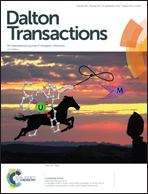Ln(iii) complexes (Ln = Eu, Gd, Tb, Dy) with a chiral ligand containing 1,10-phenanthroline and (–)-menthol fragments: synthesis, structure, magnetic properties and photoluminescence†
Abstract
A series of lanthanide(III) complexes based on the new chiral ligand L, which contains 1,10-phenanthroline and (–)-menthol fragments, namely [LnL2(NO3)3] (Ln = Eu (1), Gd (2), Tb (3), Dy (4)), have been synthesized and structurally characterized. Complexes 1–4 are isostructural and crystallize in the non-centrosymmetric space group P41212. The mononuclear complexes comprise a 10-coordinate Ln3+ ion with two bidentate N,N-donor ligands (L) and three bidentate chelating nitrate groups. The magnetic properties of complexes 1–4 are determined mainly by the Ln3+ ions. In the case of complexes 3 and 4, significant anisotropy results in nonlinear field dependences of magnetization at low temperature. Complexes 1, 3 and 4 exhibit metal-centered red (Eu3+), green (Tb3+) and yellow (Dy3+) luminescence, respectively, whereas complex 2 displays blue ligand-based luminescence in the solid state at room temperature. The luminescence quantum yield for the solid samples increases in the order 4 < 2 ≈ 3 < 1. The europium(III) complex shows long luminescence lifetimes (up to 1750 μs) and a very high quantum yield (φf = 0.87); these make this compound promising for application in sensing and optoelectronics.



 Please wait while we load your content...
Please wait while we load your content...